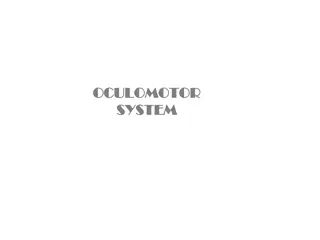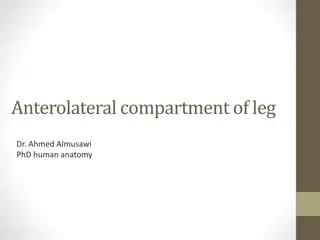Understanding Facial Nerve Disorders: An Overview
Facial nerve disorders can lead to various symptoms such as facial paralysis and otalgia. This article covers the embryology, anatomy, and neuropathophysiology of the facial nerve. The development of the facial nerve complex occurs in the early stages of gestation, and abnormalities may be associated with malformations in the ear. The intricate pathway of the facial nerve within the cranial cavity and its functions in motor, sensory, and autonomic control are also explored.
Download Presentation

Please find below an Image/Link to download the presentation.
The content on the website is provided AS IS for your information and personal use only. It may not be sold, licensed, or shared on other websites without obtaining consent from the author. Download presentation by click this link. If you encounter any issues during the download, it is possible that the publisher has removed the file from their server.
E N D
Presentation Transcript
*Facial nerve disorders and Facial nerve disorders and otalgia otalgia Dr Ali abed mohammed
Embryology The main pattern of the nerve complex course , branching pattern and the relationship is established during the first 3 months of gestation . during this period the muscles of facial expression also differentiated , became functional and actively contracted and the nerve is not full developed till the 4 years of age The facial n. develop with in the 2ndpharyngeal arch at the same time of the external and middle ear developed ( 1starch ) so abnormality of the facial n. should be anticipated whenever there is associated malformation in the external or the middle ear
Anatomy 1. Nucleus lies deeply within the substance of the pons is that situation it is closely related to the V nucleus 2. Fibers travel a circuitous route at the first backward to encircle the V6 CN nucleus in the floor of the 4th ventricle and then forward through the pons to emerge on its surface then anterolateral to enter the petrous temporal bone 3. With in the cranial cavity it is closely related to the Viii CN
4. In the intrapetrous part , the facial n. and its sensory root accompany the Viii CN in the internal auditory canal her it has anastamotic with the vestibular nerve at the bottom of this canal , it enter the facial canal which at first runs laterally above the vestibule of the labyrinth until it turns backward through a right angle on the medial wall of the promontory and then fenestera vestibuli At the medial wall of the aditus it curves downward to emerge on the inferior surface of temporal bone at the stylomastoid foramen to run forward within the parotid gland The N. supplies the following 1.Motor : muscles of facial expression , stapedius muscle , posterior belly of diagastric muscle , and stylohyoid muscle 2.Sensory : to the concha and to the parts behind the auricles 3.Autonmic fibers : for lacrimal , submandibular and sublingual glands together with glands at the nasal and oral cavities ( secretomotor and vasodilator ) 4.Special nerve taste via chorda tympani branch to supply anterior 2/3 of the tongue
Neuropathophysiology of facial nerve disorder Types of nerve injury 1. Neurapraxia is defined as a reversible blockage of the transmission of nerve impulses due to pressure on the nerve fibers. Release of the pressure usually results in rapid and complete recovery of the function with no distal Wallerian degeneration 2. Axonotmesis is a more severe injury and involves the blockage of axoplasmic flow. Although endoneural tubules are preserved, distal Wallerian degeneration occurs 3. Neurotmesis total N. transection
History the history of the onset of palsy, whether complete or incomplete, sudden or progressive. progressive facial nerve palsy over a period of more than three weeks, or an incomplete facial nerve palsy that does not start to recover after three to six weeks, should make the clinician suspect an underlying neoplasm as the cause and should dictate the need for further investigations. Ipsilateral recurrent facial nerve palsy can happen in idiopathic palsy,
physical examination Thorough head, neck, otological and cranial nerve examination is the absolute minimum required when evaluating facial nerve dysfunction complete or incomplete facial nerve palsy localize the lesion intracranial , intratemporal or extratemporal facial nerve palsy may be the first presentation of systemic illness If symptoms or signs of other cranial nerves deficits are present, a central or systemic cause should be suspected. Sparing of forehead movement is considered to be characteristic of a central lesion. However, it should be remembered that normal movement can also be seen in facial nucleus lesions and peripheral lesions of the temporal branch of the facial nerve
Grading of facial nerve palsy House Brackmann system. It has become the most widely used scheme and has been endorsed by the American Academy of Otolaryngology Head and Neck Surgery. In the House Brackmann system, grade I is normal function, grade VI is complete absence of facial motor function and grades II V are intermediate
Special investigations There are 3 important issue when confronted with facial n palsy The cause The site of lesion The prognosis
Electrophysiological test Used mainly in complete facial n palsy not in incomplete facial n palsy Currently, the two most helpful are the ENoG and EMG Electroneuronography (ENoG) Consider the most valuable prognostic indicators among electrophysiological test and the main indication is acute onset complete facial paralysis Electromyography (EMG ) Electromyography records active motor unit potentials of the orbicularis oculi and orbicularis oris muscles during rest and voluntary contraction. EMG can be used to determine: _ if a nerve in question is in fact in continuity _ if there is evidence of Wallerian degeneration _ if there are early signs of reinnervation Intraoperative nerve monitoring Intraoperative monitoring includes continuous EMG measurement from peripheral facial muscle groups and electrical stimulation of the facial nerve itself or its branches to obtain a CMAP it has a place in cerebellopontine angle (CPA) tumour surgery, in revision mastoid and parotid surgery, and in surgery of congenital ear abnormalities. Other issues to consider are medicolegal issues
Facial nerve imaging Ct scan and MRI Ct scan The tympanic portion is probably easiest to identify on axial computed tomography (CT) scans at the level of the body of incus and its short process. From there on, it can be followed proximally and distally towards the labyrinthine and descending parts, respectively The descending or mastoid segment is best visualized in coronal or saggital views. MRI Owing to the rich perineural arteriovenous plexus which surrounds the facial nerve, enhancement may be observed normally on T1-weighted magnetic resonance imaging (MRI) with the use of contrast agents. It is usually observed in more than one segment, more commonly in the geniculate ganglion and the tympanic segments and it may enhance asymmetrically between right and left.
Causes of facial palsy Birth Moulding Forceps delivery Dystrophia myotonica Moebius syndrome (facial diplegia associated with other cranial nerve defects) Trauma Basal skull fracture Facial injuries Penetrating injury to middle ear Altitude paralysis (barotauma) Scuba diving (barotauma) Lightning Neurological Opercular syndrome (cortical lesion in facial motor area)
Infection Otitis externa Otitis media Mastoiditis Chicken pox Herpes zoster cephalicus (Ramsay Hunt syndrome) Encephalitis Poliomyelitis (type I) Mumps Infectious mononucleosis (glandular fever) Leprosy Coxsackie virus Malaria Syphilis Scleroma Tuberculosis Botulism Acute haemorrhagic conjunctivitis (enterovirus Gnathostomiasis Mucormycosis Lyme disease
Metabolic Diabetes mellitus Hyperthyroidism Pregnancy Hypertension Acute porphyria Neoplastic Cholesteatoma VIIth nerve tumour Glomus jugulare tumour Leukaemia Meningioma Haemangioblastoma Sarcoma Carcinoma Anomalous sigmoid sinus Haemangioma of tympanum Facial nerve tumour Schwannoma Teratoma
Toxic Tetanus Diptheria Carbon monoxide Iatrogenic Mandibular block anaesthesia Anti-tetanus serum Vaccine treatment for rabies Post-immunization Parotid surgery Mastoid surgery Embolization Dental Idiopathic Bell s, familial Melkersson Rosenthal syndrome (recurrent alternating facial palsy, furrowed tongue, faciolabial oedema) Temporal arteritis Multiple sclerosis Myasthenia gravis
Idiopathic (Bells) palsy Bell's palsy means facial paralysis that has signs and symptoms consistent with the disease and no cause was found It includes paralysis of paresis of all muscle groups on one side of the face; sudden onset; absence of signs of central nervous system disease; and absence of signs of ear or CPA disease Male to female ratio is equal Recurrence rate 4.5 15 % 4.1 % has family history The etiology of Bell's palsy remains unclear although microcirculation failure of vasa nervorum , ischemic neuropathy , infection ,genetics and immunological causes Pathogens that have been implicated in the disease process include herpes simplex virus type 1 (HSV-1), herpes simplex virus type 2 (HSV-2), human herpes virus, varicella zoster virus (VZV), influenza B, adenovirus, Coxsackie virus and Epstein Barr virus (EBV )
The majority of patient will recover completely poor prognosis has been related to : complete paralysis at onset or incomplete paralysis with late onset of recovery, old age, a dry eye, abolished taste, absent stapedius reflex and postauricular pain. Normal function is usually regained within three months in about two-thirds of all patients. No further recovery is expected after a period of six months has elapsed Treatment Exercises Predinsone 1mg /kg for 5 days then followed by ten days taper Acyclovir 200-400 mg 5 times daily for 10 days
MelkerssonRosenthal syndrome :- In Bell's palsy recurrence is 13 % and family history is 2.5 times more Melkersson-Rosenthal syndrome, a condition also characterized by alternating recurrent facial nerve palsy associated with facial oedema, fissured tongue and a positive family history.
In contrast to recurrent ipsilateral facial paralysis, contralateral recurrence is almost always benign. Bilateral concurrent facial nerve paralysis is most probably associated with a systemic condition, such as Guillain Barre syndrome (most common), leukaemia, sarcoidosis, Lyme disease, rabies, infectious mononucleosis
Facial nerve disorder of viral origin VARICELLA ZOSTER VIRUS INFECTION (RAMSAY HUNT SYNDROME) Ramsay Hunt syndrome is a peripheral facial nerve palsy accompanied by an erythematous vesicular rash on the ear (zoster oticus) or in the mouth , The mechanism of disease is reactivation of the latent VZV virus in the geniculate ganglion
Other cranial nerves are commonly involved. The onset of pulsy is preceded by pain which may persist and be excruciating. In a small proportion of patients, the facial palsy is accompanied by a sensorineural hearing loss. The prognosis for Ramsay Hunt is worse than Bell s palsy. Persistent weakness is observed in 30 50 percent of patients and only 10 percent recover completely after complete loss of function without treatment Treatment Same as Bell's pulsy ( 2 -3 weeks ) Predison 1 mg / kg / day for 5 days follwe by 10 days taper IV acyclovir 250 mg 3 times daily or 800 mg orally 5 times daily
Facial nerve trauma management of facial nerve paralysis following trauma is generally deferred until the patient is both medically and neurologically stable MAXILLOFACIAL TRAUMA stab wound or mandible fracture Treatment by end to end anastmosis or interposition graft TEMPORAL BONE TRAUMA Longitudinal fracture---- 20 % facial palsy perigenigulate region Transverse fractures ------ higher incidence of facial nerve paralysis (50 percent) and the labyrinthine and mastoid segments are most commonly involved
Tumor involving the facial nerve Primary or secondary Primary facial nerve tumors are rare. Schwannomas and haemangiomas are the most frequent Any part of the nerve may be involved and multiple segments can be affected simultaneously Clinical features slowly progressive for n function , recurrent palsy and pain Treatment Poor facial n function -------- resection and graft Good facial n function ------- conservative treatment with regular imagining and clinical evaluation Secondary facial nerve tumors Squamous cells carcinoma or adenoid cycstic carcinoma of the parotid gland if the facial nerve is functioning preoperatively, the nerve can be preserved in most patients The facial nerve should be sacrificed if there is direct invasion of the tumour into the nerve where the tumour cannot be separated from the nerve
Otalgia Neurophysiology of pain pain as an unpleasant sensory or emotional experience associated with actual or potential tissue damage. Most otalgia is mediated via unmyelinated pain fibres, which characteristically cause a diffuse dull ache. Myelinated fibres, such as supply skin or dental enamel, are associated with much better localization and easier diagnosis. Pain may be nociceptive or neuropathic. Peripheral nociceptors respond to noxious stimuli, such as physical trauma, thermal or chemical injury or inflammation. Neuropathic pain results from core damage to the peripheral or central nervous systems or from an abnormality in the pain processing system. The resulting sharp, sudden, stabbing, lightning type of pain is typical of neuralgias
Nerve supply of the ear The auriculotemporal branch of V innervates the anterosuperior external canal and pinna, but also the temporomandibular joint. 2. The facial nerve makes a smaller contribution, providing some sensory input from the posterior tympanic membrane and external canal and the bowl of the concha. 3. Cranial nerve IX innervates the posterior external canal, meatus and tympanic membrane, but also the ipsilateral oropharynx. Its tympanic branch (Jacobson s nerve) forms the tympanic plexus, innervating the middle ear cleft. 4. The auricular branch of the vagus (Arnold s nerve) has a similar otologic distribution, but cranial nerve X has a vast dispersion to the viscera of the neck and even mediastinum 5. The upper cervical nerves C2 and C3, via the great auricular nerve and lesser occipital nerve, supply the cranial surface of the pinna, but also the skin and muscles of the neck and cervical spine. This rich innervation of the ear allows central misinterpretation of the origin of pain arising from throughout the head and neck and is the basis for referred otalgia.
Causes 1.from the ear a)From the pinna Trauma : tear , laceration , bite Heamtaoma Infected eczema Perichondritis Infected basal or squamous cell carcinoma b) from the meatus 1.impacted wax 2. impacted foreign body 3. otitis externa 4.Herps zoster oticus 5.keratosis obturance 6. furnculosis 7. malignant otitis externa 8. carcinoma
C) middle ear 1.bullous myringitis 2. traumatic perforation 3. OME 4.carcinoma 5. acute om 6. otitis baro trauma 7. hemotympanum D)mastoid 1.acute mastoiditis 2. zygomatic mastoiditis 3. Bezold's abscess 4. complications of cholesteatoma 5. cholesterol granuloma E) inner ear 1.noise 2. menieres disease 3. tinnitus 4. vestibular shwannoma
2- Referred otalgia:- Temporomandibular joint disease and dental pathologies are associated with referred otalgia via auriculotemporal nerve.. Otalgia referred from facial nerve (VII) may occur following an attack of herpes zoster. Lesions or inflammatory processes of nasopharynx, palatine tonsil, soft palate or posterior third of tongue are associated with referred otalgia via cranial nerve IX. Thyroid lesions, lesions of larynx and gastroesophageal reflux can present with referred otalgia via cranial nerve X. Pathology of cervical spine (like osteoarthritis, spondylosis, disc herniation etc.) can present with referred otalgia via greater auricular and lesser occipital nerves, derivates from C2 and C3 of cervical plexus.























